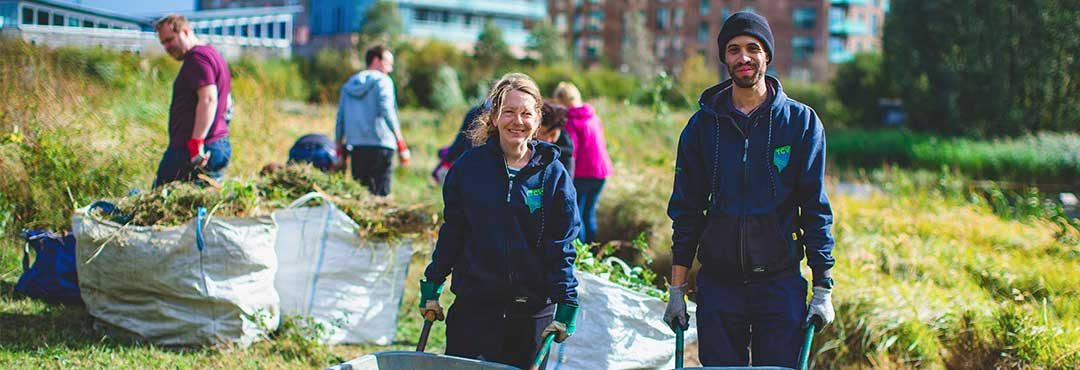Lavender Pond Nature Park was created in 1981 with the aim of providing a haven for wildlife, an amenity for local residents and an educational resource.
Despite covering only 2.5 acres, the park features a variety of habitats each with characteristics communities of plants and animals. Some areas are left as undisturbed as possible, while others are heavily used by schoolchildren and other visitors. A system of wooden boardwalks enables people to see the plants and animals at close quarters without trampling the vegetation.
The Park is continually being developed to increase its value for education, improve facilities for visitors and create new demonstration features. A network of paths have been built to provide access for people with disabilities. This network connects the classrooms within the Pumphouse to the boardwalk system by a gradual meandering ramp. Wheelchair users can also gain access from both Salter Road and Rotherhithe Street.
Volunteering at Lavender Pond
Practical volunteer activities take place on Wednesdays from 10am to 4pm.
Contact us for more details.
Contact, Access and Opening Details
During autumn and winter, the park is open on Tuesdays, Wednesdays and Thursdays from 10am to 4pm. Contact us for access outside of these times.
Lavender Pond can be found at:
Lavender Road
London SE16 5DZ
Michael Turner is the Nature Park Warden for the site. He can be contacted at M.Turner@tcv.org.uk
Tel: 020 7237 9165
Site History
The Park is set in the northern part of the former Surrey Commercial Docks, once the centre of Britain’s timber trade. It was created on the site of the former Lavender Pond, a large expanse of shallow water where timber was floated to prevent it from drying and cracking. The original entrance into the timber pond allowed small boats and lighters to enter and leave under a lifting bridge on Rotherhithe Street. This entrance was blocked in 1928 when the Port of London Authority built the Pump[house. This large and impressive building, which housed the pumps that maintained water levels throughout Surrey Docks, still dominates the scene today, one of the very few buildings left from the heyday of the docks.
The present Lavender Pond recalls the type of wetland habitats that once extended for many miles along the banks of the Thames. Trade developed rapidly in the 16th and 17ht centuries and before long, wharves and warehouses formed a continuous band on both sides of the river. Eventually, the riverside wharves and warehouses could no longer cope and that, plus the danger and delays caused by periodic gales, led to the creation of the enclosed docks.
Surrey Commercial Docks took shape over many years, starting in with the Howland Wet Dock (now Greenland Dock) in 1703. In addition to the main docks: Russia (1810), Norway (1811), Canada (1876) and Greenland (enlarged 1890s), there were the shallow timber ponds: Acorn (1811), Lavender (1815) and Quebec (1926).
The Docks played a major role in World War II, becoming a prime target for bombers. By the end of the war, 709 civilians had been killed in Bermondsey and Rotherhithe, many buildings had been destroyed and large areas of the Docks had been badly damaged.
After the War, rebuilding did take place and the Docks took on a new lease of life that continued until containerisation was introduced in the mid-1960s. then the rise of Tilbury and the East Coast ports combined with increasing mechanisation to greatly reduce the demand for traditional dock labour in the up-river docks. Surrey Docks finally closed in 1970, its 350 acres became derelict and 270 years of tradition came to an end.
After 10 years of neglect, the Pumphouse and its surroundings were in a sorry state, the old timber pond having been filled in when the docks were closed. Then. In 1981, the Pumphouse was made sound and the Nature Park was created, bringing back, not only open water, marsh, meadow, reed bed and trees, but also the name of Lavender Pond.
In 1989 the Pumphouse was renovated to become the Pumphouse Educational Museum, housing the Rotherhithe Heritage Collection.

